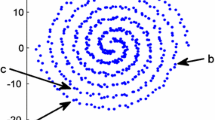Abstract
As a generalization algorithm of spectral clustering, p-spectral clustering has gradually attracted extensive attention of researchers. Gaussian kernel function is generally used in traditional p-spectral clustering to construct the similarity matrix of data. However, the Gaussian kernel function based on Euclidean distance is not effective when the data-set is complex with multiple density peaks or the density distribution is uniform. In order to solve this problem, an improved Density-based adaptive p-spectral clustering algorithm (DAPSC) is proposed, the prior information is considering to adjust the similarity between sample points and strengthen the local correlation between data points. In addition, by combining the density canopy method to update the initial clustering center and the number of clusters, the algorithm sensitivity of the original p-spectral clustering caused by the two is weakened. By experiments on four artificial data-sets and 8F UCI data-sets, we show that the proposed DAPSC has strong adaptability and more accurate compared with the four baseline methods.

Similar content being viewed by others
References
Xia K, Gu X, Zhang Y (2020) Oriented grouping-constrained spectral clustering for medical imaging segmentation. Multimedia Syst 26(1):27–36
Wu S, Song H, Cheng G et al (2019) Civil engineering supervision video retrieval method optimization based on spectral clustering and R-tree. Neural Comput Appl 31(9):4513–4525
Lierde H, Chow T, Chen G (2019) Scalable spectral clustering for overlapping community detection in large-scale networks. IEEE Trans Knowl Data Eng 32(4):754–767
Tong T, Gan J, Wen G et al (2020) One-step spectral clustering based on self-paced learning. Pattern Recogn Lett 135:8–14
Ding S, Jia H, Zhang L et al (2014) Research of semi-supervised spectral clustering algorithm based on pairwise constraints. Neural Comput Appl 24(1):211–219
Su L, Wang W, Zhang Y (2019) Strong consistency of spectral clustering for stochastic block models. IEEE Trans Inf Theory 66(1):324–338
Wang X, Ding S, Jia W (2020) Active constraint spectral clustering based on Hessian matrix. Soft Comput 24(3):2381–2390
Chen X, Sun W, Wang B et al (2018) Spectral clustering of customer transaction data with a two-level subspace weighting method. IEEE Trans Cybernet 49(9):3230–3241
Tao X, Wang R, Chang R et al (2019) Spectral clustering algorithm using density-sensitive distance measure with global and local consistencies. Knowl-Based Syst 170:26–42
Bian Z, Ishibuchi H, Wang S (2018) Joint learning of spectral clustering structure and fuzzy similarity matrix of data. IEEE Trans Fuzzy Syst 27(1):31–44
Yang X, Yu W, Wang R et al (2018) Fast spectral clustering learning with hierarchical bipartite graph for large-scale data. Pattern Recogn Lett 6(2):241–256
Li J, Xu X, Pan Z et al (2017) Improved adaptive spectral clustering NJW algorithm. Comput Sci 44(Z6):424–427
Xie J, Zhou Y, Ding L (2018) Local standard deviation spectral clustering. In: Big data and smart computing (BigComp), 2018 IEEE International Conference on. IEEE, pp 242–250
Wang Y, Duan X, Liu X et al (2018) A spectral clustering method with semantic interpretation based on axiomatic fuzzy set theory. Appl Soft Comput 64:59–74
Xie J, Ding L (2019) The true self-adaptive spectral clustering algorithms. Acta Electronica Sinica 47(5):1000–1008
Chen J, Wu Y, Lin X (2018) Automatic cluster center determination for spectral clustering. J Chin Comput Syst 8:1729–1736
Deng X, Xu Y, Chen L et al (2020) Dynamic clustering method for imbalanced learning based on AdaBoost. J Supercomput 76:9716–9738
Zhang G, Zhang C, Zhang H (2018) Improved K-means algorithm based on density Canopy. Knowl-Based Syst 145:289–297
Mccallum A, Nigam K, Ungar L (2000) Efficient clustering of high-dimensional datasets with application to reference matching. In: proc. the sixth ACM SIGKDD international conference on Knowledge discovery and data mining, pp 169–178
Wagstaff K, et al (2001) Constrained K-means clustering with background knowledge. In: proc. the 18th International Conference on Machine Learning, pp 577–584
Klaien D, Kamvar D, Manning C (2002) From instance-level constraints to space-level constraints: making the most of prior knowledge in data clustering. In: proc. the 19th International Conference on Machine Learning, pp 307–314
Luxburg U (2007) A tutorial on spectral clustering. Stat Comput 17(4):395–416
Szlam A, Bresson X (2010) Total variation and cheeger cuts. In: proc. the International Conference on International Conference on Machine Learning, pp 1039–1046
Amghibech S (2003) Eigenvalues of the discrete p-Laplacian for graphs. Ars Combinatoria 67:283–302
Bühler T, Hein M (2009) Spectral clustering based on the graph p-Laplacian. In: proc. the 26th International Conference on Machine Learning, pp 81–88
Ding S, Jia H, Du M, et al (2016) p-Spectral clustering based on neighborhood attribute granulation. In: proc. International Conference on Intelligent Information Processing, pp 50–58
Ng A, Jordan M, Yair W (2002) On spectral clustering: analysis and an algorithm. In: proc. Advances in neural information processing systems, pp 849–856
Lihi Z, Perona P (2004) Self-Tuning spectral clustering. In: proc. the 17th International Conference on Neural Information Processing Systems, pp 1601–1608
Wang L, Ding S, Jia H (2019) An improvement of spectral clustering via message passing and density sensitive similarity. IEEE Access 7:101054–101062
Guo X (2015) Robust subspace segmentation by simultaneously learning data representations and their affinity matrix. In: Proc. the 24th International Joint Conference on Artificial Intelligence, pp 3547−3553
Fan N, Pardalos P (2012) Multi-way clustering and biclustering by the Ratio cut and Normalized cut in graphs. J Combin Optimiz 23(2):224–251
Lyzinski V, Sussman D, Fishkind D et al (2015) Spectral clustering for divide-and-conquer graph matching. Parallel Comput 47:70–87
Blake C, Merz C. UCI repository of machine learning databases. http://www.ics.uci.edu/~mlearn/MLRepository.html. (accessed 1998-04-02)
Acknowledgements
This work is supported by the National Natural Science Foundation of China under Grant No. 61672522 and No. 61976216.
Author information
Authors and Affiliations
Corresponding author
Additional information
Publisher's Note
Springer Nature remains neutral with regard to jurisdictional claims in published maps and institutional affiliations.
Rights and permissions
About this article
Cite this article
Wang, Y., Ding, S., Wang, L. et al. An improved density-based adaptive p-spectral clustering algorithm. Int. J. Mach. Learn. & Cyber. 12, 1571–1582 (2021). https://doi.org/10.1007/s13042-020-01236-x
Received:
Accepted:
Published:
Issue Date:
DOI: https://doi.org/10.1007/s13042-020-01236-x




